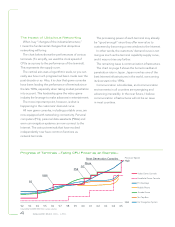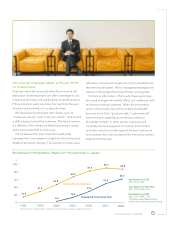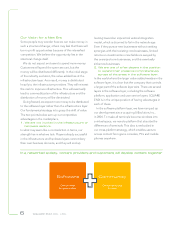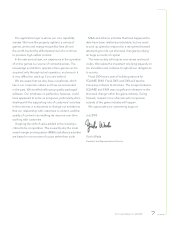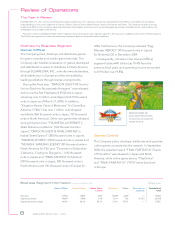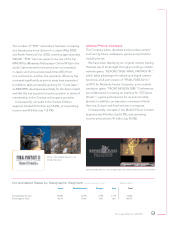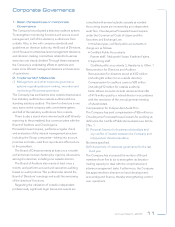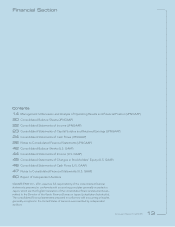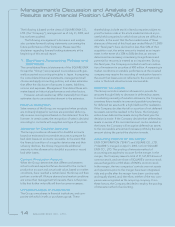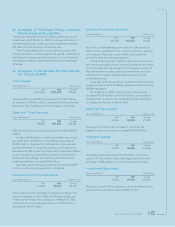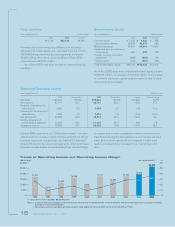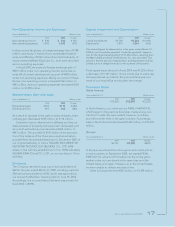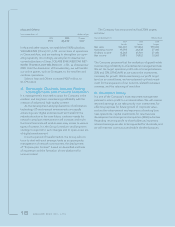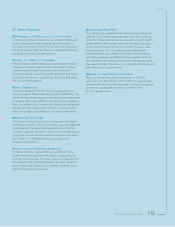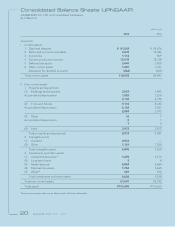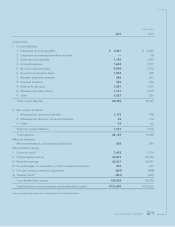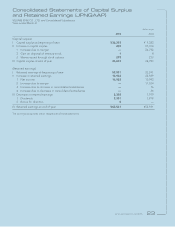Square Enix 2005 Annual Report Download - page 16
Download and view the complete annual report
Please find page 16 of the 2005 Square Enix annual report below. You can navigate through the pages in the report by either clicking on the pages listed below, or by using the keyword search tool below to find specific information within the annual report.
Management’s Discussion and Analysis of Operating
Results and Financial Position (JPNGAAP)
14 SQUARE ENIX CO., LTD.
The following is based on the views of SQUARE ENIX CO.,
LTD. (the “Company”), management as of July 31, 2005, and
has not been audited.
The following management’s discussion and analysis
also contains forward-looking statements concerning the
future performance of the Company. Please read the
disclaimer regarding forward-looking statements at the
beginning of this annual report.
1. Significant Accounting Policies and
Estimates
The consolidated financial statements of the SQUARE ENIX
Group (the “Group”) are prepared in accordance with gen-
erally accepted accounting principles in Japan. In preparing
the consolidated financial statements, management shall
choose and apply accounting policies, and make estimates
that affect the disclosure of amounts in assets, liabilities,
income and expenses. Management formulated these esti-
mates based on historical performance and other factors.
However, actual results may differ materially from these
estimates due to uncertainties inherent in the estimates.
Revenue Recognition
Sales revenue of the Group are recognized when products
are ordinarily shipped or services are provided, while roy-
alty revenue is recognized based on the statement from the
licensee. In certain cases, the recognition of sales is decided
according to contracts with suppliers and type of products.
Allowance for Doubtful Accounts
The Group provides an allowance for doubtful accounts
based on estimated irrecoverable amounts to prepare for
bad debt losses on accounts receivable. In the event that
the financial condition of a supplier deteriorates and their
solvency declines, the Group may provide additional
amounts to the allowance for doubtful accounts or record
bad debt losses.
Content Production Account
When the Group determines that differences between
actual costs and expected future demand for the content
production account and actual cash value, based on market
conditions, have reached a certain level, the Group will then
perform a write-off. If future demand and market conditions
are worse than management’s forecasts, there is the possi-
bility that further write-offs will then become necessary.
Unrealized Losses on Investments
The Group owns shares in financial institutions, and com-
panies with which it sells or purchases goods. These
shareholdings include stock in listed companies subject to
price fluctuation risks in the stock market and stock in pri-
vately held companies for which share prices are difficult to
calculate. In the event that the fair market value of these
shares as of the end of this fiscal year ended March 31, 2005
(this “fiscal year”) have declined no less than 50% of their
acquisition cost, the entire amount is treated as an impair-
ment. In the event of a 30% to 50% decline, an amount
determined as necessary considering its significance and
potential for recovery is treated as an impairment. During
this fiscal year, the Company recorded a loss from revalua-
tion of investment in securities of ¥80 million. A worsening in
market conditions or unstable performance at the invested
company may require the recording of revaluation losses in
the event that losses are not reflected in the current book
value or the book value becomes irrecoverable.
Deferred Tax Assets
The Group records a valuation allowance to provide for
amounts thought likely to decrease in deferred tax assets.
In evaluating necessity of valuation allowance, the Company
examines future taxable income and possible tax planning
for deferred tax assets with a high likelihood for realization.
If the Company decides that all or a portion of net deferred
tax assets cannot be realized in the future, the Company
writes down deferred tax assets during the fiscal year the
decision is made. If the Company decides that deferred tax
assets in excess of the recorded amount can be realized in
the future, the Company will recognize deferred tax assets
to the recoverable amount and increase profits by the same
amount during the period the decision is made.
Accounting Method for the Merger
ENIX CORPORATION (“ENIX”) and SQUARE CO., LTD.
(“SQUARE”), merged on April 1, 2003, to form SQUARE
ENIX CO., LTD. The pooling of interests method of
accounting was applied to account for the merger. In the
merger, the Company issued a total of 51,167,293 shares of
common stock, and one share of SQUARE’s common stock
was exchanged for a 0.85 share of ENIX’s common stock.
In the merger, the two companies’ controls over net assets
and operations prior to the merger have been integrated,
risks and profits after the merger have been continuously
and equally shared, and, therefore, neither of the two com-
panies was recognized as the acquiring company. From
these factors, the Company decided to employ the pooling
of interests method of accounting.


